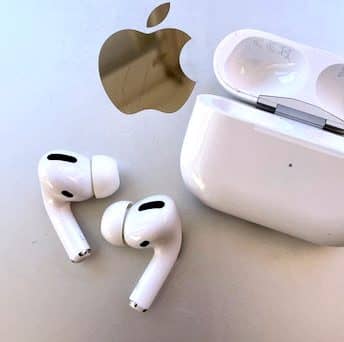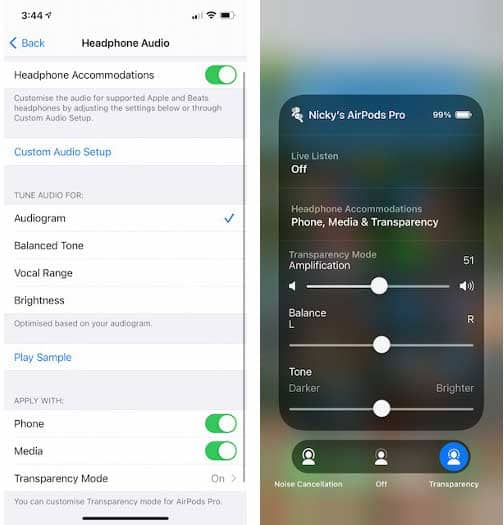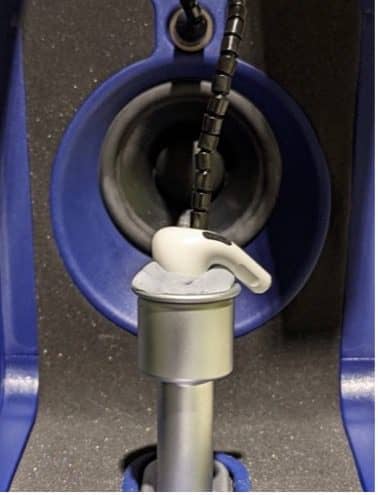Research | December 2021 Hearing Review
By Nicky Chong-White, PhD, Jorge Mejia, PhD, James Galloway, MDesSc, and Brent Edwards, PhD
The recently released Headphone Accommodations feature of Apple AirPods Pro has the potential to help people with hearing loss. When activated with Transparency mode, Headphone Accommodations applies customizable frequency-dependent gain to help the wearer better hear the sounds around them. In this article, objective measures that characterize the acoustic performance of AirPods Pro are presented. The results suggest that, while differences to traditional hearing aids exist, Headphone Accommodations provides amplification to help people with mild-to-moderate hearing loss hear sounds more easily and allow them to experience the benefits of amplification.
Many technology offerings by Apple demonstrate their growing commitment towards health and accessibility. Apple provides a number of accessibility features to benefit people who are deaf or hard of hearing. With Made for iPhone (MFi) hearing aids, users can stream audio from their iPhone directly to their hearing aids and control their hearing aid settings. The Live Listen feature helps users hear conversations more clearly by using their iPhone as a remote microphone which sends amplified sounds to their AirPods or compatible hearing aids.
Recent iOS releases have added capabilities to AirPods Pro that have the potential to help people with hearing loss. While earbuds that seal the ear canal typically block external sounds, the AirPods Pro Transparency mode uses microphones on the outside of the devices to let wearers hear the world around them (Figure 1). With the release of Headphone Accommodations in 2020, the sound picked up by these microphones is amplified with both frequency-dependency gain and compression, giving AirPods Pro hearing aid-like capability. While different gain presets can be selected from a connected iPhone, the user’s audiogram can also be entered which is then used to “fit” the gain in the AirPods Pro to their hearing loss.
With audio processing features that seem comparable to those in traditional hearing aids, there have been suggestions that AirPods Pro can be alternatives to hearing aids to help people with hearing loss hear better or, more generally, provide benefit to hearing and communication in difficult listening situations.
To determine how similar the amplification in AirPods Pro is to hearing aid amplification, we used standard hearing aid characterization methods to measure the performance of AirPods Pro. In this article, we present the findings from our objective evaluation of Headphone Accommodations with Transparency mode in AirPods Pro and provide insights into how Headphone Accommodations may benefit people with hearing loss.
Study Methods
In order to understand how AirPods Pro can help people with hearing difficulties, acoustic measurements were performed to investigate:
- Gain provided by Headphone Accommodations for a given audiogram or preset profile, and
- Other acoustic characteristics commonly used to characterize hearing aids.
Devices. For this study we used Apple AirPods Pro earbuds (with firmware version 3E751, released April 2021) paired with an iPhone running iOS 14. Settings for Headphone Accommodations were adjusted on the iPhone to tune the headphone audio to different configurations (Figure 2).
Equipment and set-up. Gain measurements were conducted in an acoustic test room as shown in Figure 3. Measures were performed using a GRAS RA0045 Ear simulator (standard IEC 60318-4 (711)) and B&K type 4190 reference free-field microphone positioned 1 meter from the loudspeaker. The RA0045 ear simulator has acoustic impedance closely resembling that of an average human ear and is widely used in verification of frequency response of consumer audio products and hearing aids.
Other acoustic measurements commonly used to determine the specifications of hearing aid characteristics according to IEC and ANSI test standards were carried out using the Aurical Hearing Instrument Test (HIT) box with 2cc coupler (Figure 4).
A) Measurements of Headphone Accommodations Gain
To determine the amount of gain provided by Headphone Accommodations, the output sound level of the AirPods Pro was measured across the range of audible frequencies. The input sound stimulus was the International Speech Test Signal (ISTS),1 presented from the loudspeaker at 50, 65, and 80 dB SPL.
Transparency Mode. As a baseline, the gain of the AirPods Pro in Transparency mode with Headphone Accommodations turned off was measured. This is the default setting for users who do not wish to apply any audio tuning profiles to the sounds around them and, according to the Apple website, “lets outside sound in, so you can hear what’s going on around you” while wearing the AirPods Pro.2

For the AirPods Pro to be acoustically transparent while being worn, the gain relative to the unaided (or unworn) condition should be 0 dB. As can be seen in Figure 5, the gain is close to 0 dB except in the 1-2 kHz and 4-6 kHz regions where resonances are present. These deviations may be transducer resonances that vary in frequency and amplitude across manufacturing batches.
Transparency Mode with Headphone Accommodations. The frequency response of the AirPods Pro can be customized by the user in three ways: 1) Using preset profiles; 2) Manually adjusting settings, and 3) Using audiogram data.
1) Using preset profiles. Headphone Accommodations comes with three preset profiles for users to select, each providing different frequency-varying gain. Figure 6 depicts the gain measured for each profile. For a 65 dB input speech level, the Balanced Tone profile provides a gain boost of around 12 dB gain between 2-5 kHz, Vocal Range has a peakier shape with around 15 dB gain between 2-5 kHz, and Brightness has a more gradually sloping gain to 4 kHz that peaks at 15 dB. Gain compression is also noted, with a compression ratio of approximately 1.5:1 at 4kHz in all profiles.

2) Manually adjusting settings. Headphone Accommodations for the preset profiles can also be manually fine-tuned. The user can adjust the amount of amplification from 0 to 100%, and the tonal balance from 0% (darker) to 100% (brighter). Additionally, the user can select the degree that soft sounds will be boosted by choosing the strength as slight, moderate, or strong.
Figure 7 shows the effects on gain for an input sound level of 65 dB SPL for the Vocal Range preset profile at slight strength when settings are adjusted. The amplification control varies gain over a 12 dB range. Tone adjustment increases the gain by up to 8 dB above 1.5 kHz while decreasing gain down to -4 dB below 1.5 kHz. Increasing the strength setting can add up to 8 dB gain per level.

3) Using audiogram data. A final way to adjust the gain in Headphone Accommodations is by using audiogram data. At the time of testing, the only way to enter an audiogram was by completing a hearing sensitivity test on the iPhone that writes the results to the Apple Health app. To allow us to enter a specific audiogram without doing a hearing test, we developed an app that allowed us to manually input an audiogram to tune Headphone Accommodations. (Note: Since this work was done, iOS 15 now allows one to enter an audiogram manually.) We created 3 custom audiograms, as shown in Figure 8, and measured the gain provided by Headphone Accommodations for each of these hearing losses (Figure 9). For comparison to what an audiologist-fit hearing aid would provide for people with these audiograms, real-ear insertion gains specified by NAL-NL2 are also shown.
As can be seen, NAL-NL2 generally prescribes a steeper gain curve than what Headphone Accommodations provides. Note also that NAL-NL2 also prescribes a higher compression ratio than what Headphone Accommodations provides, as demonstrated by the wide spread between gain curves for different input levels. Headphone Accommodations is most closely matched with NAL-NL2 at normal conversational levels (65 dB SPL), but generally provides greater amplification at loud input levels (80 dB SPL) and lower amplification at soft sound levels (50 dB SPL).

B) Other Measurements
Industry standards ANSI S3.22:2014 and IEC 60118-7:2005 specify methods for characterizing the acoustic performance of hearing aid devices. Therefore, AirPods Pro performance was measured in adherence to these standards, where appropriate, allowing for comparisons to be made with traditional hearing aids (Table 1).

A brief description of the measures performed:
- Output SPL for 90-dB input SPL (OSPL90) is used to approximate the maximum output level performance of the device.
- Total Harmonic Distortion is a measure of distortion caused by nonlinearities in the audio throughput. Lower numbers indicate better sound quality.
- Equivalent Input Noise is a measure of the device’s internal noise, typically caused by the microphone. Lower numbers indicate better sound quality.
- Attack and release times measure the speed of the compressor.
The OSPL90 for AirPods Pro is less than 100 dB, more than 10 dB lower than typical hearing aids. Whereas hearing aids are designed specifically to amplify sound for people with mild to severe hearing loss, the max output level of AirPods Pro suggests they are more suited to provide amplification for mild-moderate losses. As very high audio levels can cause hearing damage, consumer devices such as headphones and earbuds often limit maximum output levels for hearing safety.
Total harmonic distortion is very low for the AirPods Pro. The attack time is fast, indicating the compression responds quickly to reduce the gain of high-level sounds. The release time is slower than some hearing aids but faster than others.
However, the measured equivalent input noise for the AirPods Pro in Transparency mode was higher than typical hearing aids, which suggests that users with near-normal hearing thresholds may perceive some audible sound, such as a faint background hiss, when using Transparency mode in very quiet environments.
Final Observations
AirPods Pro with Headphone Accommodations in Transparency mode enable people with hearing loss to hear quiet sounds more easily by providing frequency-dependent gain amplification and compression. The preset profiles are suitable for those with mild-to-moderate sloping hearing loss and can allow them to experience the benefit of amplification. Sound preferences can be fine-tuned to adjust the strength, tone, and overall amount of amplification.
The gain provided by Headphone Accommodations for a given audiogram does not compensate for the reduced audibility and reduced loudness across the range of input sound levels in the same way that traditional hearing aids fit to NAL-NL2 do. In particular, loud sound levels are generally over-amplified in the AirPods Pro compared to NAL-NL2, while soft sound levels are under-amplified.
References
- Holube I, Fredelake S, Vlaming M, Kollmeier B. Development and analysis of an International Speech Test Signal (ISTS). Int J Audiol. 2010;49(12):891-903. doi:10.3109/14992027.2010.506889
- Apple Inc. AirPods Pro and AirPods Max Active Noise Cancellation and Transparency mode. Available at: https://support.apple.com/en-us/HT210643
- Keidser G, Dillon H, Flax M, Ching T, Brewer S. The NAL-NL2 prescription procedure. Audiol Res. 2011;1(1):e24. doi:10.4081/audiores.2011.e24
CORRESPONDENCE can be addressed to Dr Chong-White at: [email protected].
Citation for this article: Chong-White N, Mejia J, Galloway J, Edwards B. Evaluating Apple AirPods Pro with Headphone Accommodations as hearing devices. Hearing Review. 2021;28(12)8-11.
About the authors: Nicky Chong-White, PhD, is a Senior Research Engineer at the National Acoustic Laboratories (NAL) in Sydney, Australia. Since joining NAL in 2004, she has applied her background in speech and audio signal processing, acoustics, machine learning and software development to investigate hearing. Jorge Mejia, PhD, is Head of Signal Processing at NAL. His current research is focused on developing technology to improve speech understanding in noise for people with hearing impairments, understanding the real-world benefit of established and emerging hearing technologies, and developing artificial intelligence solutions. James Galloway, MDesSc (Audio & Acoustics), is a Research Engineer at NAL responsible for facilitating research experiments and conducting electroacoustic analysis. Brent Edwards, PhD, is Director at NAL. For over 22 years he has led R&D teams at major hearing aid companies and Silicon Valley startups that have developed innovative signal processing algorithms, fitting procedures, diagnostics and outcome measures, wireless technologies, transducers, and other technologies that have benefited hearing aid wearers and hearing care professionals worldwide.










